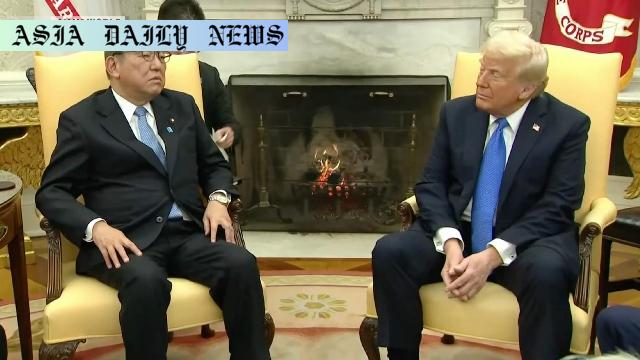Indo-Pacific: Enhancing Security & Economy With US-Japan Ties
- Key Point 1: The US and Japan pledged stronger defense cooperation for an open Indo-Pacific.
- Key Point 2: The leaders emphasized countering economic coercion, aligned on supply chains.
- Key Point 3: Article Five of the Japan-US Security Treaty applies to the Senkaku Islands.
- Key Point 4: Focused on trade imbalances, enhanced investments, and tech collaboration.
- Key Point 5: North Korea denuclearization and Taiwan Strait stability were prioritized.

Strengthening Indo-Pacific Security through US-Japan Cooperation
The recent summit between Japanese Prime Minister Ishiba Shigeru and US President Donald Trump marked a pivotal moment in bolstering US-Japan relations. Both leaders pledged to enhance their nations’ deterrence and response capabilities, ensuring a free and open Indo-Pacific. This cooperation aims to counter regional tensions while emphasizing shared values of peace and stability.
Countering Challenges from China
A significant focal point of the summit was addressing China’s assertive moves in the region. The Japanese leader reiterated that Article Five of the Japan-US Security Treaty would extend to the Senkaku Islands in Okinawa, ensuring US defense obligations for the contested islands. Both nations shared concerns over the Taiwan Strait, a region critical for global trade and security. This larger strategy reflects a united stance against unilateral actions disrupting regional stability.
Collaborating through Quad and other Global Frameworks
The commitment to international partnerships was underscored with a renewed emphasis on the Quad Security Dialogue involving the US, Japan, Australia, and India. The dialogue serves as a crucial framework to address pressing security and economic challenges. As key allies in the Indo-Pacific, Japan and the US aim to work closely with other global partners to uphold regional peace.
Economic Strengthening: Investments, Trade, and Supply Chains
Economic collaboration also formed a cornerstone of the summit. Ishiba highlighted Japan’s consistent role as the largest investor in the US for the past five years, proposing to scale investment further to over $1 trillion. President Trump welcomed these developments while pointing out trade imbalances, proposing actionable steps to address a $100 billion US trade deficit with Japan.
Technological and Energy Cooperation
The leaders committed to advancing technologies like artificial intelligence and semiconductor development while ensuring energy security. Increased liquefied natural gas (LNG) exports from the US to Japan aim to fill energy needs and strengthen trade ties. This partnership reflects a forward-looking approach, leveraging technological solutions for mutual benefit.
Progress on North Korea and Humanitarian Issues
North Korea’s escalating nuclear advancements remain a shared concern. Both leaders reaffirmed their goal of achieving the complete denuclearization of the Korean Peninsula. Additionally, President Trump extended firm support to Prime Minister Ishiba regarding the immediate resolution of the abduction of Japanese nationals by North Korea, underlining a deep humanitarian commitment.
Global Reactions and Strategic Implications
Taiwan President Lai Ching-te expressed support for remarks on ensuring stability in the Taiwan Strait, emphasizing solidarity with the US, Japan, and other partners. This summit demonstrates a strong commitment to fortifying alliances and addressing shared challenges. As global dynamics shift, the strategic cooperation demonstrated by the US and Japan provides a beacon for other nations to strengthen multilateral ties.
Future Prospects for the Indo-Pacific Alliance
The Indo-Pacific stands at the crossroads of global security and economic transformations. By combining military deterrence with economic resilience, strengthened by robust international cooperation, Japan and the US set the stage for sustainable progress. This summit has reaffirmed their pivotal role in navigating regional issues and securing peace and economic growth.



Commentary
A Comprehensive Overview of the US-Japan Dynamic
The Ishiba-Trump summit stands as a testament to the power of global partnerships in an increasingly complex geopolitical landscape. By addressing diverse challenges such as regional security, trade imbalances, and technological advancements, the summit emphasized the depth of the US-Japan alliance — a necessary safeguard for the modern Indo-Pacific region.
Balancing Security and Economy
It is particularly noteworthy how both leaders seamlessly intertwined security measures with economic strategies. By strengthening deterrence systems, addressing Article Five obligations, and advancing supply chain stability, this summit shone a spotlight on the delicate interdependence of geopolitics and economic health. Ensuring Taiwan Strait stability further demonstrates their commitment to settling longstanding regional tensions.
Strategic Implications for the Quad and Beyond
Another critical highlight is the focus on Quad collaboration. This coalition’s growing significance cannot be overlooked as it seeks to counterbalance China’s influence in the Indo-Pacific. By aligning with other major players like India and Australia, the US and Japan enhance the Quad’s potential to foster a multipolar, balanced global order.
Looking Forward
As the Indo-Pacific continues to emerge as a fulcrum of global interaction, the strength of US-Japan relations remains pivotal. This summit serves both as a reaffirmation of past commitments and a roadmap for future aspirations. Their combined efforts will inevitably shape the region’s evolving dynamics, promising peace, security, and prosperity.